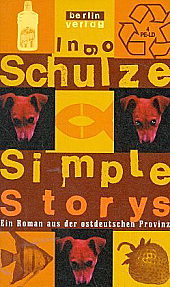Ingo Schulze is that rare commodity: a contemporary German writer with an American following. His important works have been translated by John E. Woods into English and his latest novel – Adam und Evelyn – will be released to American readers in November of this year. And Schulze himself has a strong affinity for America and American writing. His 1998 novel Simple Storys not only has a germanicized American title, it was inspired by Schulze's reading of the American master of the short story Raymond Carver – as well as Robert Altman's 1993 film Short Cuts, where the great director wove together nine Carver stories into a coherent narrative.
In the 29 stories of Simple Storys Ingo Schulze creates a mosaic of East German anxiety after the Wende of 1989. Like Raymond Carver. Schulze fixes his gaze on men and women – coming together, breaking up, or on the verge of break-up. Like Carver he uses mise-en-scène to bring the reader into bedroom or kitchen of (usually two) characters, and we are forced to try to create our own narrative meaning from snippets of dialogue and carefully observed details of the milieu. Characters are introduced and disappear in subsequent stories, only to reappear much later as a narrator of yet another story. There are at least a dozen essential figures, and one needs an Excel spreadsheet and flowchart to keep track of the characters and different narrative threads. Schulze appropriates some of Raymond Carver's story lines: there is the fatal car accident of A Small, Good Thing; there is fishing trip that finds death lifted from So Much Water, So Close to Home. But Schulze lacks the soulfulness of Carver. And, where Carver's characters often appear lost in the expansive majesty of the Pacific Northwest, Schulze's characters in Storys lead cramped lives circumscribed by the gray small city of Altenburg in Thuringia. In this drab reality, Ingo Schulze excels as a miniaturist – something Carver never really aspired to.
What is this new post-Wende reality – the subject of all of Schulze's work? For the most part, the characters in Storys struggle with their new found freedom – or are ruthlessly exploited by interlopers from the West. In Neues Geld ("New Money") – Schulze's reprise of Hemingway's short story Up in Michigan – the teenage waitress Conni is raped by an American real estate developer out to make a fast profit in the newly capitalist territories. Meaningful employment vanishes, and people are forced to find "McJobs" – if they are lucky. An art history scholar loses his place at the university and is forced to walk the city streets in a frogman suit to lure customers to a seafood restaurant. The existential struggle against the repressive DDR state has dissolved into an existential struggle by two sales reps for the newspaper advertising account of a furniture retailer. And it turns out that the new "freedom of the press" is not all it is cracked up to be, as the editor of the local newspaper "revises" (censors) a reporter's article on local skinhead thugs, so as not to scare away advertisers.
Remnants ot the DDR are everywhere – not least in the consciousness of the characters. Some are incapable of making the adjustment to the new reality – or, like the former teacher Ernst Meurer, are haunted by their Stasi sins of the past. Others – the more ruthless ones – swim comfortably in the new waters. The Wall and border guards may be gone, but the emotional walls and psychic scars remain. Folks can reunite with family members in the West – but the reunions leave something to be desired. In one of the best stories (Lächeln) the former art historian seeks out his father whom he hadn't seen in 25 years after the father abandoned his family to flee to the West. The father apparently feels little or no remorse and instead tries to convert his lost son to a fundamentalist Christianity.
Schulze unfortunately toys with the reader all too often – deliberately leading one into blind alleys. Dr Barbara Holitzschek shows up to work distraught because she had run over a "badger" with her car. Much later we learn in a different story that she, in fact, may have run over a young mother on a bicycle. In the end, Simple Storys is unsatisfactory, not because Ingo Schulze demands so much from the reader, but because we don't care enough about the characters to expend the energy to make sense of their stories.
For Schulze the elaborate jigsaw puzzle of Simple Storys becomes an end in itself; the book was likely more fun to write than it is to read.



0 comment
There are at least a dozen key figures, and has an Excel spreadsheet and a chart to follow the different characters and the son of the narrative.